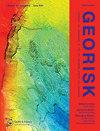洪水风险制图补贴的概念与分析框架
IF 4.8
3区 工程技术
Q1 ENGINEERING, GEOLOGICAL
Georisk-Assessment and Management of Risk for Engineered Systems and Geohazards
Pub Date : 2022-07-27
DOI:10.3390/geohazards3030020
引用次数: 4
摘要
在定量损伤分析中,暴露物的定义值和类别分类仍存在空白。本文提出了一个在地方尺度上完善洪水风险分析发展的框架。本研究首先进行了定量的风险分析,主要基于二手数据;然后,它试图以图形方式传达结果,旨在减少所需的财政和人力资源。我们提出了一个易于标准化的数据库在GIS环境中,分析水库对防洪的影响和可复制的地方规模的风险曲线的建设。采用水文(HEC-HMS)和二维水动力(HEC-RAS)模型模拟考虑不同回归期的水文曲线。对于损坏估计,处理包括地块矢量化,使用谷歌街景定义建筑用途,标准设计分类,以及验证这些类别的实地调查。在货币价值方面,本研究计算了水库建设对减少损失的影响,显示了确定所采取的减轻洪水影响措施的有效性的潜力。此外,对于每个模拟回归期,可以建立暴露、危害和损害图,从而可以执行完整的风险分析。本文章由计算机程序翻译,如有差异,请以英文原文为准。
Conceptual and Analytical Framework as Flood Risk Mapping Subsidy
There are still gaps in defining values and category classifications of exposed items in quantitative damage analysis. This paper proposes a framework that refines the development of flood risk analysis at a local scale. This study first performs a quantitative risk analysis, based mainly on secondary data; it then attempts to communicate the results graphically, aiming to reduce the financial and human resources required. We propose an easily standardized database in a GIS environment, analyzing the influence of a reservoir for flood control and the construction of replicable local-scale risk curves. Hydrological (HEC-HMS) and 2D hydrodynamic (HEC-RAS) models were used to simulate hydrographs considering different return periods. For damage estimation, the processing included vectorization of lots, building use definition with Google Street View, classification of standard designs, and a field survey to validate those classes. In monetary value, this study calculated the effect of the construction of a reservoir for damage reduction, showing the potential to determine the effectiveness of measures adopted to mitigate flood impacts. In addition, for each simulated return period, exposure, hazard, and damage maps can be established, making it possible to perform a complete risk analysis.
求助全文
通过发布文献求助,成功后即可免费获取论文全文。
去求助
来源期刊
CiteScore
8.70
自引率
10.40%
发文量
31
期刊介绍:
Georisk covers many diversified but interlinked areas of active research and practice, such as geohazards (earthquakes, landslides, avalanches, rockfalls, tsunamis, etc.), safety of engineered systems (dams, buildings, offshore structures, lifelines, etc.), environmental risk, seismic risk, reliability-based design and code calibration, geostatistics, decision analyses, structural reliability, maintenance and life cycle performance, risk and vulnerability, hazard mapping, loss assessment (economic, social, environmental, etc.), GIS databases, remote sensing, and many other related disciplines. The underlying theme is that uncertainties associated with geomaterials (soils, rocks), geologic processes, and possible subsequent treatments, are usually large and complex and these uncertainties play an indispensable role in the risk assessment and management of engineered and natural systems. Significant theoretical and practical challenges remain on quantifying these uncertainties and developing defensible risk management methodologies that are acceptable to decision makers and stakeholders. Many opportunities to leverage on the rapid advancement in Bayesian analysis, machine learning, artificial intelligence, and other data-driven methods also exist, which can greatly enhance our decision-making abilities. The basic goal of this international peer-reviewed journal is to provide a multi-disciplinary scientific forum for cross fertilization of ideas between interested parties working on various aspects of georisk to advance the state-of-the-art and the state-of-the-practice.

 求助内容:
求助内容: 应助结果提醒方式:
应助结果提醒方式:


